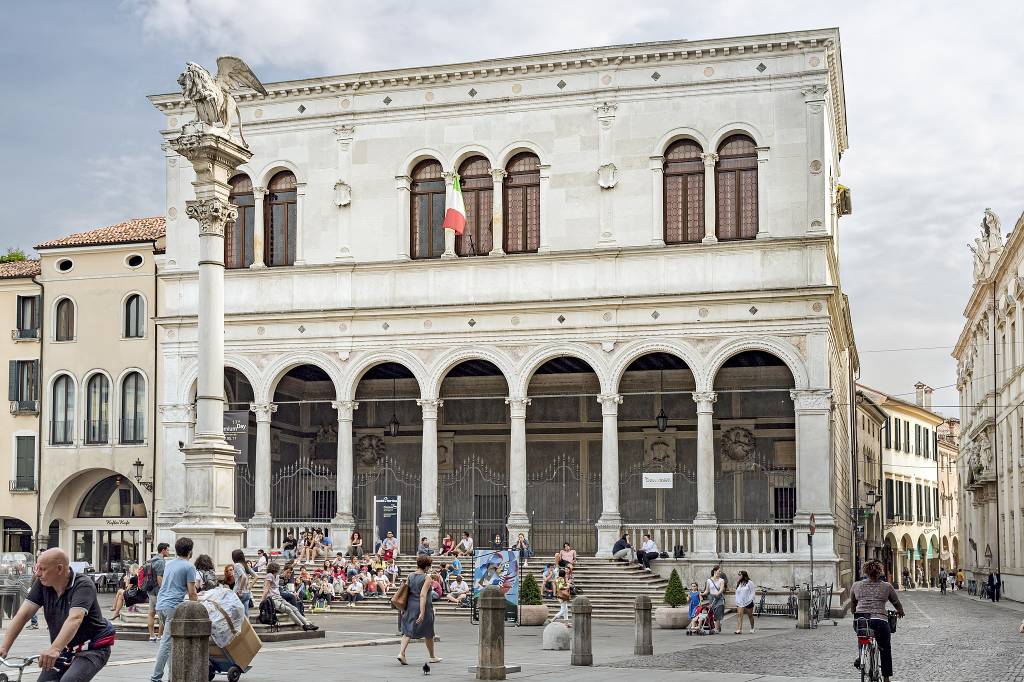The Council Loggia
One of the beautiful Venetian buildings surrounding the square of Piazza dei Signori is Loggia del Consiglio, an outstanding example of the architecture of the 15th and 16th centuries.

The splendid Loggia del Consiglio, also known as the Loggia della Gran Guardia, is a Renaissance building that stands in the southwest corner of Piazza dei Signori, the true heart of the city.
The elegant building was built on a 1496 project by Annibale Maggi da Bassano to accommodate the city council following the fire that damaged the Palazzo della Ragione in 1420. It was finished in 1553 by Giovanni Maria Falconetto, an Italian architect who designed two of the first high Renaissance buildings in Padua, the Loggia and Odeo Cornaro. The ancient seat of the Council became the seat of the "Gran Guardia", the military command of the cities during the Austrian domination.
The Loggia, with its harmonious proportions and sober elegance, is a classic representation of the new Renaissance, a true masterpiece of local architecture from the transition period between the 15th and 16th centuries. The elegant and delicate facade is characterized by the use of polychrome marble and by the particular decorations of the columns along with the three mullioned windows on the upper floor. A wide staircase leads into the ground floor portico formed by seven arches supported on columns and pillars with a beamed ceiling richly decorated with coats of arms.
The great council chamber is embellished with a coffered ceiling and a series of frescoes, painted by Pier Antonio Torri in 1667. On the east wall, a canvas depicting Padua between Justice and Wisdom, a replica by an uncertain author, which replaces the original painting made by Domenico Campagnola in 1537 and is now preserved in the Eremitani Civic Museums.
The Council Loggia has been part of the municipal heritage since 1866 and has been mainly used for cultural initiatives. It is a symbol of the cultural Padua as well as a meeting point for citizens and tourists
We welcome all contributions, no matter how small. Even a spelling correction is greatly appreciated.
All submissions are reviewed before being published.
Continue to changelogWe welcome all contributions.
All submissions are reviewed before being published.
We welcome all contributions, no matter how small. Even a spelling correction is greatly appreciated.
All submissions are reviewed before being published.
Continue to changelogWe welcome all contributions, no matter how small. Even a spelling correction is greatly appreciated.
All submissions are reviewed before being published.
Continue to changelogWe welcome all contributions, no matter how small. Even a spelling correction is greatly appreciated.
All submissions are reviewed before being published.
Continue to changelogCategory
Cost
-
Torre dell'Orologio is a medieval clock tower which rises between the Piazza del Capitaniato and Piazza dei Signori, representing one of the symbols of the Carrarese era in Padua.
-
44 m
Piazza dei Signori is an elegant open square surrounded by monumental works, fulfilling the role of the grand living room of Padua.
-
The Church of San Clemente is a small Baroque-style Roman Catholic church with an ancient history overlooking the Piazza dei Signori.
-
117 m
The masterwork by Giusto de' Menabuoi, the frescoes are inspired by scenes from the Old and New Testaments, which culminates in the splendid image of Christ in Paradise
-
The Chapel with its frescoes painted by Guariento is a fantastic testimony of the splendor of what used to be the Carrara Palace